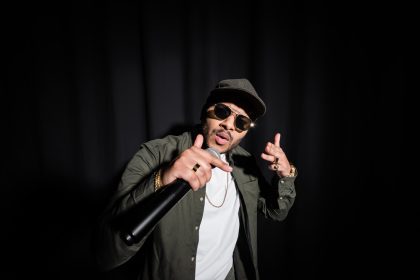
The quote “Fear kills more dreams than failure ever will” sums up Jabari Dreams of Freedom, a play about a Black kid from the South Side of Chicago, who interacts with children from the civil rights era through his dreams to gain the courage to conquer the challenges of his day. The play opens with a disruptive classroom scene, where the children are focused on everything but the teacher’s assignment. There’s a frustrating aloofness to Jabari (played by Phillip Cusic), who like many young Black boys his age, appears glib and uninterested in just about anything that isn’t sports or music related.
By stripping away the almost instinctive desire to make Jabari overly verbose and animated, director Lili-Anne Brown does a great job of capturing the authenticity of Jabari’s age and culture. Young audiences can to relate to a withdrawn kid who is more interested in doing the Shmoney dance, Nae Nae, and the Stanky leg than a homework assignment. The timely cultural references are almost necessary to influence buy-in for the heavier parts of the play that come later.
Jabari’s interaction with Ruby Bridges, the first black child to integrate the all-white William Frantz Elementary school in New Orleans, Louisiana in 1960, offers moments of chilling reflection. Upon learning of the challenges of Jabari’s day, Bridges asks “Why would chocolate people want to hurt other chocolate people?” The question, as simple as it seems, would be quite alarming to a young person fighting for justice and equality for people who looked like her. She then sums up their interaction by saying, “Who are you gonna be Jabari?”

To that end, Jabari Dreams of Freedom has a pretty lofty goal – to show young people that they can be active members of social change. Creator Nambi E. Kelley is gambling on the idea that the stories of powerful children in history can be a beacon of light for young people today. The hope is that she’s right, but even if the connection is not direct, there is power in planting the seed. Kelley’s message certainly wasn’t lost on nearly 100 school children from Chicago’s Englewood neighborhood who assembled for a peace march after their classmate was killed. After hearing of this, Chicago Children’s Theatre supporters sponsored these children to see a show.
From a technical perspective, the set for Jabari Dreams of Freedom was quite simple and relied heavily on a video backdrop to keep the audience engaged. Will Bishop did a great job of transforming a classroom with six chairs into a bus, a television station, and a platform for a Dr. King speech. Costuming for the play was fun and colorful an assisted in youthening an adult cast. If there is a criticism of Jabari, it’s that the play was over too soon. Jabari Dreams of Freedom runs 60 minutes, but could have easily squeezed another 30 minutes in to further explore his interactions with friends from the past and present. Speaking of friends, Jabari Dreams of Freedom was outfitted with a strong cast including Gavin Lawrence, who plays his father (and has a real life son named Jabari), and ensemble members Leslie Ann Sheppard, Emily Glick, Matt Keffer, and Patrick Agada.

With the current challenges African Americans face, this writer simply cannot equivocate on the importance of this play. While Jabari Dreams of Freedom offers a poignant and powerful message to all children, it is a play that Black children in Chicago simply cannot afford to miss. With that, Jabari Dreams of Freedom offers a sociocultural challenge of its own – how do Black children on the south and west sides of Chicago (who need this message the most), make it to the heart of Chicago’s Gold Coast to experience this play?
Jabari Dreams of Freedom runs until May 1 at the Ruth Page Center for the Arts located at 1016 N. Dearborn St. Run time is 60 minutes with no intermission. Tickets are available at: chicagochildrenstheatre.org.









